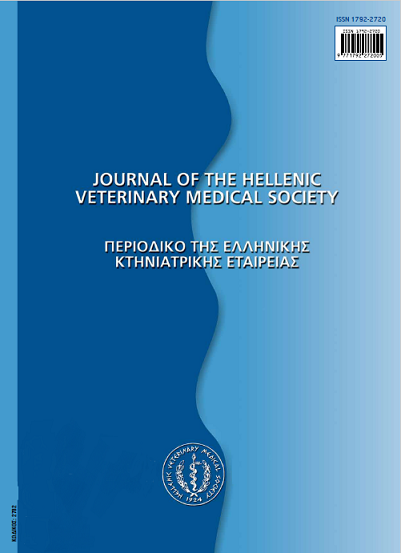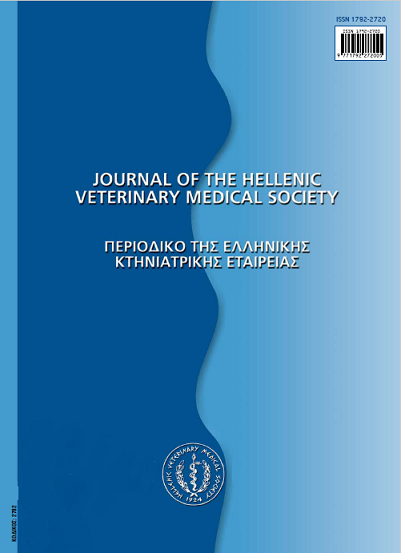Pain assessment and treatment in equines
Аннотация
Current concepts in pain on animals suggest that -at least- mammals perceive and experience pain like humans do. Pain receptors are the free nerve endings. Qualitative analysis and interpretation is done in brain cortex (somatosensory area), while nociception may be done in lower centres. Pain may be physiological or clinical. In physiological pain, short acting noxious stimuli act on nociceptors and produce pain, but without any neurophysiological modification. In clinical pain, mostly intense noxious stimuli bring alterations in neuronal physiology, in central nervous system (central sensitization), as well as in peripheral nervous system (peripheral sensitization). Eventually, pain threshold is reduced and hyperalgesia is established. Clinical pain may be inflammatory or neuropathic. According to its origin, it may be somatic (skin, bones, joints, muscles), which is acute and may be accurately localized, or visceral (from the abdominal and thoracic organs), which is blunt and diffuse. Post-operative pain mayprolong hospitalization and increase morbidity. Pain management is mandatory for humane, legal and medical reasons. The latter include elimination of side effects of catecholamine production, facilitation of healing and restoration of the animal's normal functions (diet, self-care, etc.), which in general reduce the response to stress. Moreover, organ function is improved and morbidity is reduced. As a result, peri-operative analgesia may improve health, as long as most analgesic techniques improve organ function post-operatively. The first indication of pain in animals is behavioural alteration. In chronic pain, metabolic disturbances may alsooccur. In normal equines, it seems that there are variations among individuals. In general, it is easier to diagnose an acute abdominal pain than a chronic pain in joints, tendons or bones. In acute pain, the horse develops special facial expression. The animal looksbackwards and kicks the ground. Peripheral somatic pain may produce acute signs. Pain is definitely treated only after diagnosing itscause. However, it may also be treated symptomatically with analgesics and local denervations. Additionally, trans-cutaneous electrical nerve stimulation (TENS) of peripheral nerves or other sights of central nervous system may alleviate pain (electroanalgesia). Finally,acupuncture maybe applied. Among the analgesic drugs, in equines, opioids (morphine, methadone, pethidine, butorphanile) produce very good analgesia and mild sedation. Respiratory and intestinal contractility depression is common side effect. Central nervous system excitations maybe seen, especially after morphine administration. Local anaesthetics produce excellent analgesia and maybe used pre- (pre-emptive analgesia), intra- (to reduce general anaesthetic dose rates) and post-operatively. a2-Adrenergic agonists produce analgesia, mainly visceral. They are very good analgesics in cases of colics, whereas their sedative effects reduce the incidence of self-trauma. Their major disadvantage is cardiovascular depression. Non-steroidal anti-inflammatory drugs (NSAIDs) have very good anti-inflammatory properties. They are used in cases of acute pain, traumatic or surgical, as well as in chronic pain.
Article Details
- Как цитировать
-
AMANITI (Ε.Μ. ΑΜΑΝΙΤΗ) E. M., SAVVAS (Ι. ΣΑΒΒΑΣ) I., & DIAKAKIS (Ν. ΔΙΑΚΑΚΗΣ) N. (2018). Pain assessment and treatment in equines. Journal of the Hellenic Veterinary Medical Society, 61(2), 134–143. https://doi.org/10.12681/jhvms.14882
- Выпуск
- Том 61 № 2 (2010)
- Раздел
- Review Articles

Это произведение доступно по лицензии Creative Commons «Attribution-NonCommercial» («Атрибуция — Некоммерческое использование») 4.0 Всемирная.
Authors who publish with this journal agree to the following terms:
· Authors retain copyright and grant the journal right of first publication with the work simultaneously licensed under a Creative Commons Attribution Non-Commercial License that allows others to share the work with an acknowledgement of the work's authorship and initial publication in this journal.
· Authors are able to enter into separate, additional contractual arrangements for the non-exclusive distribution of the journal's published version of the work (e.g. post it to an institutional repository or publish it in a book), with an acknowledgement of its initial publication in this journal.
· Authors are permitted and encouraged to post their work online (preferably in institutional repositories or on their website) prior to and during the submission process, as it can lead to productive exchanges, as well as earlier and greater citation of published work.












